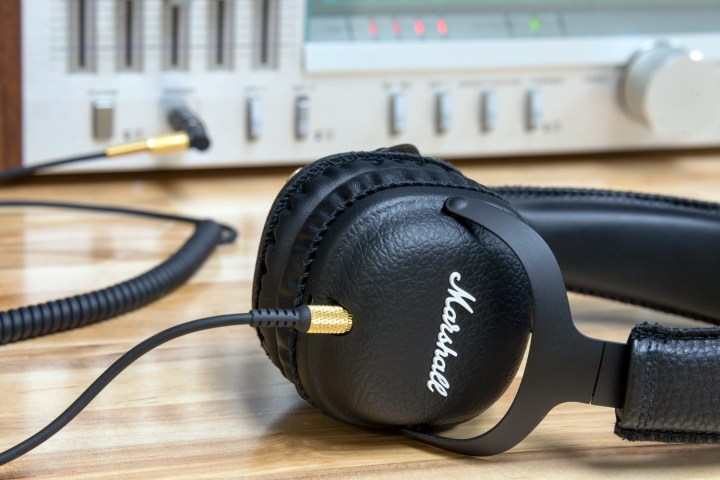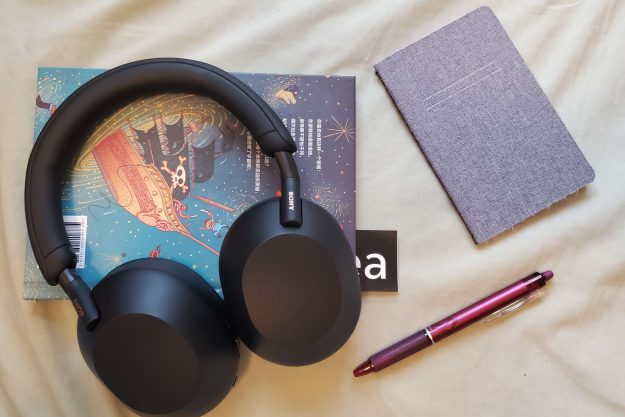
“Great sound, a low price, and excellent functionality make Marshall’s latest Bluetooth on-ears an absolute joy.”
- Clear, warm, and detailed sound
- Boosted bass excites without dominating
- Intuitive controls
- Great battery life
- Good passive noise isolation
- Clamping force a bit tight
- No case included
Vintage design, low cost, and great sound have had us smitten with just about everything famed English guitar amp pioneer Marshall has sent our way since it began licensing headphones a few years ago. The wired and wireless versions of the company’s Major II on-ear were a mainstay in our office’s testing stable for months thanks to their warm sound, great controls, and excellent battery life.
With even more dynamic sound and still-superb functionality, the company’s new Mid Bluetooth headphones are everything we hoped to see in an upgrade. Though they offer a somewhat more restrained sound signature than their playful predecessors (as they should with this higher price point), the Mid subtly shape audio in a way that we love, providing a thin, fuzzy blanket to wrap around our favorite tracks du jour.
Out of the box
Right from the get go, you’ll find personality in the Marshall Mid. The headphones come in a medium-sized black box with the company’s classic logo on the front, an image of tattooed hands raising them to the lords of rock on the rear. Opening the box reveals the black
In-box accessories include a 3.5mm audio cable and micro-USB charging cable. Like all Marshall Headphones cables, they’re shaped like shrunken-down guitar cables, with the headphone cable sporting small textured brass accents near both jacks. A simple black user manual occupies the bottom of the box.
Features and design
The Mid stick to a similar visual aesthetic as the Major II, but with a few new style elements; the textured vinyl with brass accents are still here, but this time the rectangular, amp-shaped earcups are slightly more sculpted. The company’s iconic white cursive logo appears prominently as ever on the outside of each earcup, a visual cue that makes it seem as though a set of tiny half-stacked amps are pumping rock straight into your cerebellum.
Despite a more modern design, the Marshall Mid are aimed at those with a soft spot for vintage rock and roll. Two coiled cables run between each earcup — an old-school look sported by studio headphones at the height of the ‘70s studio era — and the textured exterior leaves little to draw your eye, aside from the classic Marshall font. In keeping with the gold-and-vinyl theme, the right and left earphones are marked by stamped brass R+L symbols on the lower section of the headband. These are on-ears that pair well with cowboy boots, dark blue denim, and a nice leather jacket.
Everything you listen to through the Mid sounds like it’s filtered through a tube amp.
The vast majority of the physical differences between the Major II and the Mid come as upgrades to modest design problems. Case in point: The lower section that attaches the headband to the earcups is thicker and sturdier than it is on the Major II, which featured less-durable wire brackets. And while the padded earcups and headband appear to be virtually identical on both models, Marshall’s Mid ditches the rattan-stitched interior driver covers, opting instead for a soft audio cloth that likely improves clarity.
The headphones fold into a pinched “U” shape when not in use, indicative of their relatively heavy clamping force. While this means the Marshall Mid have impressive passive noise isolation, it can also make them uncomfortable for long listening sessions, especially for those with larger heads or glasses. Like their predecessors, the Mid fold easily into a compact ball thanks to hinges on the band, only they’re lower now to more easily allow for size adjustment.
Speaking of adjustment, the headband’s brushed-black metal clicks between various size settings in approximately quarter-inch increments, rather than the free-flowing manner employed by many headphone makers, which keeps the band more secure during storage.
Like the Major II, the Mid’s included audio cable is coiled to keep it out of the way, as well as giving the forgetful among us a bit of a physical reminder before we inadvertently reach the end of our tether when plugged in. A single-button control piece and microphone allow for receiving calls analog style.
As for on-board controls, we’re happy to see the Mid employing the same pencil-eraser shaped control key as its predecessor, located at the back of the left earcup. Pressing up or down on the brass knob raises volume, side-to-side movement changes songs, and pressing directly down allows for pause/play or fielding calls. In the interest of simplicity, the knob has also replaced the Major II’s power key, making it all powerful and making the Mid that much cleaner in design. Other on-board features include dual jacks for audio input and charging respectively at the bottom of the right earphone.
The 30 hours of battery life we enjoyed on the Major II are also carried over in the Mid; The headphones lasted nearly a full week at the office, with a relatively short recharge time of under an hour.
Setup
Setting up the Marshall Mid headphones is as simple as pressing the brass button twice, waiting for an ascending series of tones to indicate that they are on, then selecting the
As is typical with
Audio performance
Like other Marshall Headphones gear we’ve tested over the years, the Mid are by no means a flat, audiophile-tuned operator — a fact the company is so open about that it shows off its scooped equalization profile on the back of the box.
Instead, a re-tuned set of 40mm dynamic drivers and higher-quality Bluetooth aptX connectivity combine with the Marshall Mid’s great passive noise isolation to create an extremely fun listening experience for most music. The warmth we enjoyed in the midrange of the Major II is still here, but it’s now complemented by more shimmer in the treble as well as a more restrained bass punch, leading to a sound that’s flatter overall, but somehow more enjoyable to listen to.
Everything you hear through the Mids sounds like it’s coming through a high-end tube amp. Everyday audio becomes warmer, punchier, and more vibrant, even if it isn’t always mastering-studio accurate.
Classic rock hits like Fleetwood Mac’s The Chain showcase clean acoustic and bold electric guitar tones clearly on either side of the stereo mix, blending well with mid and low-end information. And while the headphones are certainly bass-heavy (as were their predecessors), this time they’re a bit nimbler, with a punchy mid-bass boost that bolsters kick drums and bass lines, rather than muddying the waters further up.
This boosted low end means classical music like the New York Philharmonic’s recordings of Vivaldi’s Four Seasons sounds slightly unbalanced, but classic rock tracks like those on Led Zeppelin’s remastered first album sound so good you’ll have a tough time wiping a Cheshire-cat grin off your face.
Hints of modernity give way to a fun, vintage rock aesthetic.
The Mids can take anything with shrieking vocals, punchy kick drum, and buttery electric guitar or keyboard, and create a positively delectable musical meal, from The Who (incidentally, the band who put Marshall on the map) to Elton John and beyond. In fact, we were hard-pressed to find any classic rock that didn’t pair perfectly with Marshall’s mighty on-ears.
But it’s not just classic rock that becomes warmer and more fun; Even classic jazz records like Miles Davis’ Bitches Brew or On The Corner sound great through the Marshall Mid, with each musical ingredient coming through distinctly, even in an extremely busy mix.
Soul-sampling hip-hop like that of Jay Z’s debut album Reasonable Doubt is equally dynamic, with the Mid’s warm mid-palate perfectly showcasing the vocals and the punchy bass forcing you to shake your whole body where you’d previously only be bobbing your head.
Are there flatter-sounding on-ear headphones for the same price? Yes. Are there more comfortable on-ear
Our Take
The Marshall Mid headphones are an extremely warm and dynamic pair of Bluetooth
Is there a better alternative?
Those looking for solid wireless on-ear options at a similar price point have a plethora of options. The excellent Plantronics Backbeat Pro 2 offer a much more restrained aesthetic, but also add in noise canceling, while Marshall Headphones’ own Major II will save you $50 or more, while offering a similar overall experience.
How long will it last?
Given the Marshall Mid’s solid build quality and Marshall’s good name, we expect these headphones to last for years, provided one is careful when travelling — they don’t include a case.
Should you buy it?
Yes. The Marshall Mid
Editors' Recommendations
- Report: Sonos Ace headphones will get wired and wireless lossless audio
- Marshall’s latest headphones get 100 hours of battery life and wireless charging
- Sony WH-1000XM6: the design and features we want Sony’s next headphones to deliver
- The best kids headphones of 2024: for fun, safety, and sound
- The best wireless headphones for 2024 from Bose, Sony, 1More and more









